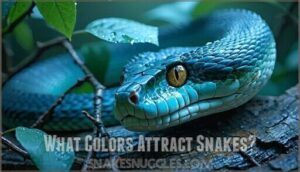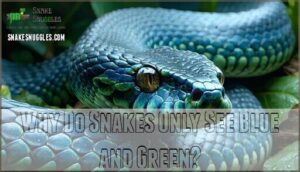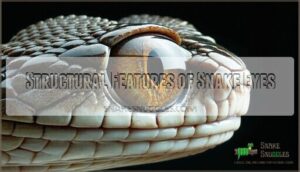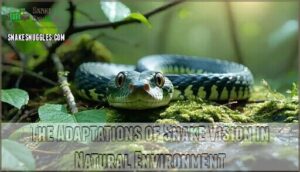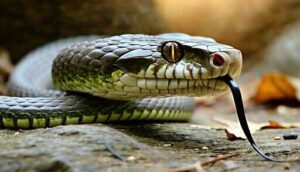This site is supported by our readers. We may earn a commission, at no cost to you, if you purchase through links.
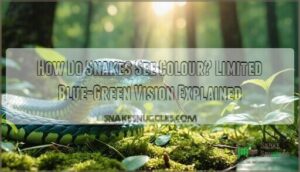 You’re probably curious about how snakes see color, and the answer might surprise you.
You’re probably curious about how snakes see color, and the answer might surprise you.
Most snakes can’t see the full rainbow like you can – they’re dichromatic, meaning they primarily see blues and greens while missing reds entirely.
This limited color vision stems from having only two types of cone cells in their eyes compared to your three. Scientists discovered that snakes possess three visual pigments, but two work mainly in cone cells for daylight vision.
This blue-green spectrum actually serves them well in their natural environments, helping them spot prey movement and navigate through vegetation.
However, some sea snakes have regained broader color vision through evolution, showing nature’s remarkable adaptability in different habitats.
Table Of Contents
- Key Takeaways
- How Do Snakes See Colour?
- How Do Snakes See Color?
- A Snake’s Perception of Color
- What Colors Attract Snakes?
- Why Do Snakes Only See Blue and Green?
- Understanding Snake Eyesight
- The Adaptations of Snake Vision in Natural Environment
- Tongue and Heat Pit Complement Snake Vision
- Frequently Asked Questions (FAQs)
- What colors attract snakes?
- Can snakes detect color?
- Why can snakes only see blue and green?
- Can snakes see in total darkness?
- How do snakes see color?
- Why do snakes only see blue and green?
- How good is a snakes’ eyesight?
- What colours can snakes not see?
- Do snakes have different coloured eyes?
- Can snakes see heat?
- Conclusion
Key Takeaways
- You’ll see a limited blue-green world – Snakes have dichromatic vision with only two cone types, so they can’t perceive reds, oranges, or pinks like you can
- Evolution shaped their visual limitations – When ancestral snakes adapted to burrowing lifestyles, they lost red-sensitive cone cells since color discrimination wasn’t essential underground
- They’ve got backup sensory systems – Your snake compensates for limited color vision with heat-sensing pit organs, forked tongues for chemical detection, and enhanced motion detection abilities
- Some species broke the rules – Sea snakes regained broader color vision through gene duplication, proving that evolution can reverse color blindness when environmental pressures demand it
How Do Snakes See Colour?
Unlike humans with trichromatic color vision, you’ll find snakes possess dichromatic vision limited to blue and green wavelengths.
Their retinas contain specialized rods and cones with visual acuity adapted for motion detection.
Most species can’t perceive red, though some have UV vision capabilities.
Certain pythons and vipers combine limited color perception with infrared detection through specialized pit organs, creating a unique sensory system that compensates for restricted snake vision in the color spectrum.
How Do Snakes See Color?
You’ve likely wondered how snakes perceive the colorful world around them, and the answer might surprise you.
Unlike humans who see a full spectrum of colors, snakes possess dichromatic vision that limits them to primarily blue and green hues, which is a key aspect of their visual perception, particularly in terms of colorful environments.
Evolution of Snake Vision
You’ll discover how snake vision evolved from their lizard ancestry through fascinating genetic adaptation.
Burrowing adaptations reduced color perception as environmental pressures favored other visual strengths.
Here’s how the evolution of snake vision unfolded:
- Ancient snakes lost full color perception when adapting to underground life
- Gene duplication events created new visual capabilities in some species
- Ancestral lizards possessed advanced tetrachromatic vision systems
- Early burrowing lifestyle reduced reliance on color discrimination
- Modern snakes developed enhanced movement detection and infrared abilities
Limited Color Perception in Snakes
Snake color perception operates through dichromatic vision, restricting them to blue-green hues while lacking red perception.
This colorblindness stems from evolutionary adaptations when ancestral snakes adopted burrowing lifestyles, losing red-sensitive cone cells.
Most species can’t distinguish red objects, seeing them as darker blue-green shades.
However, many retain UV sensitivity, helping them detect prey trails and navigate environments.
Their snake color blindness represents an evolutionary trade-off, prioritizing motion detection over color vision.
Unique Adaptations for Specific Environments
Environmental pressures shape snake vision in remarkable ways. Habitat vision drives these evolutionary changes, creating specialized visual adaptations in snakes across different ecosystems.
- Arboreal color discrimination helps tree-dwelling species navigate complex canopy environments with enhanced green-spectrum sensitivity
- Aquatic sight improvements allow sea snakes to regain color perception through Opsin SWS1 gene duplication for underwater hunting
- Burrowing adaptations reduce cone density in subterranean species, prioritizing motion detection over dichromatic vision
Camouflage evolution and snake visual ecology demonstrate how snake color perception mechanisms respond to environmental demands.
A Snake’s Perception of Color
You’ll discover that snakes possess a fascinating yet limited color vision system that evolved through millions of years of adaptation.
Their visual world centers around blue and green wavelengths, creating a unique perspective that differs dramatically from human color perception.
Opsin SWS1 Gene and Color Vision
Deep within color perception mechanics, the Opsin SWS1 gene creates visual pigments that detect specific light wavelengths.
This gene has undergone remarkable evolutionary advantage transformations in sea snakes.
The annulated sea snake vision showcases gene duplication – possessing four SWS1 copies instead of typical single versions.
Two copies maintain UV sensitivity for detecting short wavelengths around 360-450 nanometers, while others evolved detecting longer wavelengths common in ocean environments.
This adaptation expands dichromatic vision capabilities beyond standard blue-green limitations.
Ultraviolet vision helps locate prey through reflective urine trails, demonstrating how genetic modifications enhance survival.
Such color vision adaptations represent rare evolutionary events where environmental pressures drove sophisticated visual system developments.
Sea Snakes and Regained Color Vision
The remarkable sea snakes showcase evolutionary flexibility by regaining color vision after millions of years.
Unlike their terrestrial ancestors who lost full-color capabilities, these marine reptiles faced new Marine Adaptation Pressures that favored enhanced visual systems.
Their success stems from three key innovations:
- Opsin Gene Copies multiplication – The annulated sea snake possesses four copies of the Opsin SWS1 gene, dramatically expanding color perception beyond typical snake limitations.
- Aquatic Color Evolution – Dormant opsin genes reactivated and duplicated, creating specialized proteins optimized for underwater light conditions.
- Habitat Vision Needs alignment – Enhanced blue-green sensitivity helps distinguish prey, predators, and mates in complex coral reef environments.
This Snake Ancestry Reversal represents one of nature’s most fascinating comebacks, proving that color vision in reptiles can evolve when survival demands it.
Impact of Color Vision on Ecology
You’ll discover how color perception shapes every aspect of snake vision and environmental adaptation.
Coloration camouflage directly influences predator avoidance strategies, while prey selection depends heavily on a snake’s ability to distinguish targets from backgrounds.
Habitat adaptation drives evolutionary changes in visual systems – arboreal species develop enhanced discrimination for canopy navigation, while burrowing snakes lose color detection entirely.
Mating signals rely on specific color patterns that males recognize during breeding season.
The ecological role of visual ecology extends beyond hunting, affecting territorial behavior, threat assessment, and survival strategies across diverse environments.
What Colors Attract Snakes?
Understanding what colors attract or influence snakes requires examining how their limited blue-green vision affects their behavior.
You’ll discover that while snakes can’t see the full spectrum humans enjoy, their dichromatic vision still plays a vital role in prey identification, predator avoidance, and mating rituals.
Prey Identification Through Color
A snake’s color perception plays a vital role in successful prey identification, even with their limited blue-green vision.
You’ll find that snakes have developed remarkable strategies to maximize their hunting effectiveness despite seeing fewer colors than humans.
Their dichromatic vision actually works perfectly for their environmental needs.
Snakes excel at detecting subtle variations within their blue-green spectrum, allowing them to spot prey against natural backgrounds.
Laboratory studies show arboreal snakes achieve an 80% success rate in color-based hunting tasks, proving their visual efficiency.
Here’s how snakes use color discrimination for prey identification:
- Enhanced contrast detection – They distinguish prey from foliage by recognizing color differences within their limited spectrum
- Movement-triggered color processing – Rod cells amplify color perception when detecting motion, improving prey tracking accuracy
- UV light advantage – Some species use ultraviolet vision to spot reflective urine trails left by small mammals
- Juvenile prey selection – Young snakes rely heavily on color cues, with studies showing 40% improved strike accuracy when using color discrimination techniques
This specialized color vision system proves that evolutionary limitations can become survival advantages.
Some vendors offer products that simulate natural prey coloration to better understand snake behavior.
Camouflage and Color Adaptations
You’ll notice how snakes use their limited color perception alongside camouflage effectiveness to survive in diverse habitats.
Habitat coloration plays a vital role in their visual adaptation strategies. Green tree pythons blend seamlessly with foliage, while desert species match sandy browns through evolutionary pressures.
This color polymorphism isn’t random—it’s shaped by predator avoidance needs and hunting success. Snake vision may be limited to blue-green hues, but their color perception still helps them assess camouflage quality.
Environmental demands drive these adaptations, creating perfect matches between snake colors and their surroundings for maximum survival advantage.
Role of Color in Mating Behaviors
You’ll find color preference plays a vital role in mate selection among snakes.
Visual cues help identify suitable partners, with sexual dimorphism often expressed through distinct snake colors.
Male garter snakes demonstrate strong preferences for females displaying specific skin patterns during courtship.
This color sensitivity directly influences breeding success, as color perception guides mating behaviors and enhances sexual selection processes in various species.
Why Do Snakes Only See Blue and Green?
Snakes only see blue and green because their ancestors adapted to burrowing lifestyles where color vision wasn’t essential for survival.
This genetic limitation stems from the loss of specific photoreceptor cells during evolution, restricting them to dichromatic vision compared to humans’ three-color perception.
Adaptive Limitations and Environmental Context
Understanding environmental context reveals why snakes developed their unique visual limitations.
Evolution shaped their color perception through specific Habitat Vision demands and Sensory Tradeoffs. Here’s how different environments influenced snake vision:
- Burrowing Adaptations reduced color needs in dark underground tunnels
- Nocturnal Vision prioritized movement detection over dichromatic color discrimination
- Diurnal Vision species retained better color abilities for daylight hunting
- Ocean habitats prompted sea snakes to regain enhanced color capabilities
- Color blindness became advantageous when other senses proved more reliable
This dichromatic system isn’t a flaw—it’s an efficient adaptation to their ecological niche.
Genetic Basis for Limited Color Vision
While environmental factors shaped snake vision, the genetic basis reveals why snakes can’t escape their dichromatic limitations.
Opsin gene loss and cone cell evolution created these visual constraints through millions of years of genetic changes.
You’ll find that snake color vision stems from specific genetic adaptations:
- Opsin SWS1 gene mutations eliminated sensitivity to red wavelengths, restricting vision to blue-green spectrums
- Ancestral genes from lizard predecessors underwent selective pressure, favoring reduced color discrimination over enhanced motion detection
- Gene duplication events in sea snakes represent rare reversals, where species regained expanded color vision through genetic innovation
- UV vision genes persist in some species, allowing detection of prey trails invisible to human eyes
This genetic basis for color blindness origin demonstrates how gene evolution responds to environmental demands, creating dichromatic vision genes perfectly suited for snake survival strategies.
Understanding gene expression reveals how traits manifest.
Understanding Snake Eyesight
You’ll find that snake eyes contain fascinating structural differences from human vision systems that directly impact their color perception abilities.
These unique anatomical features work together with specialized sensory organs to create a visual experience that’s perfectly adapted for survival in their specific environments, utilizing specialized sensory organs.
Structural Features of Snake Eyes
You’ve learned why snakes can’t perceive red hues, but their eyes themselves tell an equally fascinating story.
Snake vision relies on several unique structural adaptations that set them apart from mammals.
Your typical snake eye lacks eyelids—instead, spectacle scales act as transparent protective shields.
These clear coverings shed with the snake’s skin, maintaining crystal-clear vision throughout their lives.
The spherical lens differs dramatically from your flatter human lens, providing sharper focus capabilities.
Within the retina, specialized photoreceptor cells work overtime.
Rods and cones populate this light-sensitive layer, with cone cells enabling limited color detection.
Retinal cells process visual information efficiently, while some species boast UV vision through specialized receptors.
A common issue arises when snakes experience retained eye caps, often due to improper humidity levels.
Many snakes possess pit organs—heat-sensing structures that complement traditional sight.
These remarkable adaptations create a visual system perfectly tuned for survival.
| Structure | Function |
|---|---|
| Spectacle Scales | Transparent eye protection |
| Spherical Lens | Enhanced focus capability |
| Retinal Cells | Light processing and detection |
Comparative Vision Across Reptiles and Mammals
When you compare snake vision to other reptiles and mammals, you’ll discover fascinating differences in Color Vision Evolution.
Most snakes possess dichromatic vision with two cone types, while many lizards retained tetrachromatic capabilities from ancestral forms.
Nocturnal vs Diurnal species show distinct Cone Cell Diversity patterns – diurnal snakes maintain more cones for enhanced color perception, whereas nocturnal varieties rely heavily on rod cells for motion detection.
UV Light Perception varies across species, with some snakes detecting ultraviolet wavelengths that humans can’t see.
This Sensory System Integration between vision and other senses creates unique comparative vision advantages in reptile vision systems.
Snakes, however, generally lack the ability to see a wide range of colors.
Specialized Functions of Snake Vision
Several specialized functions make snake vision uniquely adapted for survival.
Their dichromatic vision system, with specialized cone cells and visual pigments, excels at detecting specific environmental cues that matter most for their lifestyle.
Snake vision offers three key advantages:
- Motion sensing: You’ll find snakes are masters at spotting even subtle movements, thanks to their high concentration of rod cells that detect changes in light patterns
- Prey identification: Despite limited color perception, snakes effectively identify potential meals by recognizing shapes, sizes, and movement patterns rather than relying on full-spectrum vision
- Infrared detection: Many species combine visual input with heat-sensing pit organs, creating a dual-imaging system that reveals warm-blooded prey even in complete darkness
This streamlined visual system proves that you don’t need human-level color vision to thrive.
Snakes have evolved depth perception and UV vision capabilities that complement their dichromatic setup, creating an efficient sensory package perfectly suited to their hunting strategies.
The Adaptations of Snake Vision in Natural Environment
Snakes have evolved remarkable visual adaptations that help them thrive in their natural environments despite limited color perception.
You’ll discover how these reptiles combine their blue-green vision with specialized hunting strategies and enhanced motion detection to successfully navigate their world.
Hunting Strategies and Motion Detection
You’ll notice how snake vision combines with hunting strategies to create deadly efficient predators.
Ambush tactics dominate – snakes use camouflage reliance and remain motionless until prey approaches.
Their motion detection abilities excel at spotting movement, while limited color perception doesn’t hinder strike precision.
Nocturnal hunting species compensate with enhanced prey tracking through heat-sensing pit organs and vibration detection.
Cave dwelling snakes, however, use heat sensitive receptors to hunt in total darkness.
Sensory Complementarity for Effective Prey Detection
You’ll discover that snakes don’t rely solely on their limited blue-green color perception for prey detection.
Their olfactory cues through tongue-flicking provide chemical information about potential meals.
Heat detection via pit organs reveals warm-blooded prey locations, while vibration sensing through ground contact alerts them to movement.
Snakes use specialized tools for enhanced thermal accuracy.
This sensory integration creates thorough environmental perception, making sensory complementarity far more effective than visual perception alone.
Nocturnal Advantage and Visual Acuity
Hunting under cover of darkness, nocturnal snakes possess remarkable Low-Light Vision adaptations that give them distinct advantages.
You’ll find these serpents equipped with enhanced Rod Sensitivity and Pupil Dilation capabilities that maximize light capture during Night Hunting expeditions.
Here’s how nocturnal snakes achieve superior visual acuity in darkness:
- Rod Sensitivity increases dramatically, detecting minimal light levels
- Motion Detection becomes highly refined for tracking prey movement
- Pupil Dilation expands to capture maximum available light
- Vertical pupils provide precise depth perception control
- Enhanced snake eyesight compensates for limited color perception
Tongue and Heat Pit Complement Snake Vision
While you can observe a snake’s limited blue-green color vision, you’ll notice it relies heavily on its forked tongue and specialized heat-sensing pits to create a complete sensory picture of its environment.
These complementary systems work together to detect chemical trails, temperature differences, and prey locations that vision alone can’t provide, using specialized heat-sensing pits.
Olfactory Role in Snake Behavior
While snake vision captures prey movement, you’ll discover their forked tongues deliver chemical intelligence that’s equally vital for survival.
This scent-based hunting system transforms how snakes navigate and detect threats in their environment.
Here’s how olfactory navigation works:
- Prey detection – Forked tongues collect airborne molecules, transferring chemical data to specialized organs for analysis
- Pheromone communication – Social signaling between snakes occurs through chemical messaging during mating seasons
- Environmental mapping – Olfactory role helps snakes track scent trails, identifying safe routes and territorial boundaries
This chemical perception complements limited color perception, creating a thorough sensory system for snake behavior.
Some researchers have explored snake pheromone attractants to better understand snake behavior.
Infrared Sensing for Thermoregulation and Predation
When you’re exploring infrared sensing, you’ll discover snakes possess specialized pit organs that detect thermal signatures with remarkable precision.
These sophisticated sensors, positioned between the nostrils and eyes in pit vipers, pythons, and boas, enable effective thermoregulation strategies and nocturnal hunting success through infrared prey detection.
Snakes use these pit organs to detect infrared radiation with high accuracy.
| Pit Organ Function | Primary Benefits |
|---|---|
| Heat detection | Locates warm-blooded prey in darkness |
| Thermoregulation | Identifies ideal basking spots |
| Environmental sensing | Maps heat signatures for navigation |
Your understanding of thermal vision reveals how snakes integrate infrared sensing with limited color perception.
This heat detection capability transforms nocturnal hunting from guesswork into precision targeting.
Environmental heat signatures guide snakes toward prey that might otherwise remain invisible in complete darkness.
Infrared vision compensates for dichromatic color limitations, creating an extensive sensory system that’s perfectly adapted for survival in diverse habitats.
Synergistic Integration of Sensory Inputs
While infrared detection helps you track warm-blooded prey, snakes truly excel through sensory integration that combines multiple inputs into one powerful hunting system.
You’ll witness how snake vision, chemical detection, and heat sensing work together to create enhanced predation capabilities that give these reptiles significant survival advantages in their environments.
Here’s how snakes achieve multisensory perception:
- Visual perception merges with chemical cues from tongue-flicking to create detailed environmental maps
- Color perception combines with infrared data to distinguish between living prey and background objects
- Motion detection works alongside heat signatures to track moving targets with remarkable precision
- Environmental awareness increases when all sensory systems provide complementary information about surroundings
This sensory integration transforms basic snake senses into sophisticated detection networks that outperform individual systems working alone.
Frequently Asked Questions (FAQs)
What colors attract snakes?
Contrary to popular belief that bright colors repel snakes, you’ll find they’re actually drawn to warmer environments rather than specific hues.
Since snakes see primarily blue-green tones, they respond more to heat signatures than visual colors when hunting.
Can snakes detect color?
Yes, you can count on snakes detecting color, though they’re dichromats seeing mainly blue and green wavelengths.
They’ve lost red perception through evolution but retained useful color discrimination for hunting and navigation, which allows them to see mainly blue and green wavelengths.
Why can snakes only see blue and green?
Snakes can’t see red because they’re dichromats with only two types of color receptors, unlike humans who’ve three.
This evolutionary adaptation stems from their ancestral burrowing lifestyle, where color discrimination wasn’t essential for survival.
Can snakes see in total darkness?
Most can’t see in complete darkness, but they don’t need to.
You’ll find that pit vipers, pythons, and boas use specialized heat-sensing organs to detect warm-blooded prey by their infrared signatures alone.
How do snakes see color?
Like a painter with a limited palette, you’ll discover snakes see colors differently than humans. They’re dichromats, perceiving mainly blue and green wavelengths while missing reds completely.
Why do snakes only see blue and green?
Evolutionary pressure shaped their vision when early snakes adapted to burrowing lifestyles, losing full-color perception that their lizard ancestors possessed. You’re seeing nature’s trade-off between color discrimination and survival needs.
How good is a snakes’ eyesight?
Vision quality varies dramatically among snake species depending on their lifestyle and habitat.
Diurnal snakes like false water cobras have excellent eyesight, while nocturnal and burrowing species rely more on other senses for navigation.
What colours can snakes not see?
Snakes can’t see red, orange, or pink colors because they’re dichromats with only blue and green color vision.
You’ll notice they miss warm-toned colors that appear as cooler blue-green shades instead.
Do snakes have different coloured eyes?
You won’t believe it, but snakes aren’t stuck with boring brown eyes.
They’ve got quite the rainbow collection – from bright yellow and orange to deep red, blue, and even striking silver.
Each species rocks its own signature eye color, making them truly unique with their signature eye colors.
Can snakes see heat?
You might be surprised, but some snakes actually "see" heat using special pit organs between their eyes and nostrils.
This lets them sense infrared radiation, so they can detect warm-blooded prey even in total darkness.
Conclusion
Imagine walking through a forest, seeing only shades of blue and green like a snake does.
When you ask, "how do snakes see colour," remember that their vision is shaped by evolution and environment.
Snakes rely on this limited palette to spot prey and stay safe.
Their eyes, genes, and even heat-sensing pits work together for survival.
Understanding how snakes see colour helps you appreciate their unique adaptations and the fascinating ways they navigate their world.
- https://www.ncbi.nlm.nih.gov/pmc/articles/PMC2833736/
- https://www.amnh.org/explore/news-blogs/news-posts/pit-vipers-can-detect-prey-via-heat
- https://animals.mom.com/snakes-flick-tongues-3367.html
- https://www.nhm.ac.uk/discover/news/2016/september/study-sheds-light-on-snake-vision.html
- https://www.quora.com/Do-snakes-have-clear-vision-and-if-so-what-colors-do-they-see-best





